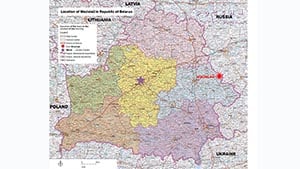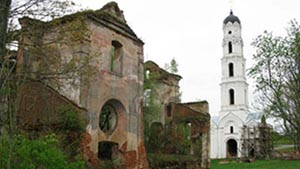COMUS Pilot town: Mstislav, Belarus


Number of inhabitants: 10 376 (2016)
Area (km²): 15 square kilometers / about 6 square miles
Mstislav is a town in Mogilev Region, Eastern Belarus.
Mstislav is one of the oldest cities in Belarus. Its name is associated with the best pages of the history book of the Belarusian people, their spiritual and cultural identity. According to written sources, its foundation dates back to 1135. Its architectural and planning structure has formed over centuries.
In the 12th century, Mstislav comprised only the castle and the town around it (pasad). The castle was located on the site of the ancient settlement called "Castle Hill", on the elevated right bank of the river Vichra, and was then fortified by the henge-circle with wide and deep moats. In the 12th-14th centuries, the surrounding town (pasad) occupied an area of about 4.5 hectares/ 11.1 acres, and together with the city-fort (detinets) was approximately 6 hectares/ 14.8 acres. In the late 15th - early 16th centuries, the city experienced numerous invasions by the troops from Moscow Principality, which did not contribute to the development of the city. Therefore, in the 15th-16th centuries the city actually remained within its boundaries of the 12th-13th centuries. The late 16th and early 17th centuries was a time when the city flourished. In 1634 the city was granted Magdeburg rights and the city's coat of arms, which featured "a hand armed with a sword in a gold box, also called "the Small Pahonia". Due to the subsequent peaceful life, Mstislav kept growing and developing socially and economically. Four monasteries and city fortifications were built, the market square, merchants' rows and city dwellings saw development too. It was the centre of Mstislav Starostva (eldership), one of the richest and the most beautiful cities at the eastern border of the Grand Duchy of Lithuania. In the 16th century it was the centre of the Belarusian book printing, tile and glass trades. Mstislav was the place of birth, life and work of Pjotr Mscislavec, a student of Francysk Skaryna, the founder of Slavic book printing.
In 1654, during the Russo-Polish War of 1654–1667, also called the Thirteen Years' War, Mstislav was seized by Moscow's troops and almost completely destroyed. It was unable to restore its former glory in the following centuries. In 1772 the city became part of the Russian Empire as a centre of the province in the Mahilioŭ area. In 1781 it received a new coat of arms: a red fox against a silver background, which remains the city's coat of arms today.
Modern Mstislav is the administrative centre of Mstislav District in the Mahilioŭ region. It is located 13 kilometres from the border with Russia and 95 kilometres from Mahilioŭ. The nearest railway station is 15 kilometres to the west of the city. It is a highway junction on the way from Mahilioŭ to Khislavichi (Russia). It is known for its outstanding archaeological and architectural heritage: ancient hill forts, churches and monasteries, historical buildings and the international medieval festival, which is held there annually.
 outputs
outputs
Mstislav
- Heritage Assessment Report (HAR)
- Preliminary Technical Files (PTF)
- Reference Plan (RP) in Belarusian + Action 1.1 / Action 2.1 / Action 3.1 / Action 4.1 / Action 5.1
- Preliminary Technical Assessments (PTA) :
- PTA1-Restoration of Carmelite church and the unique frescoes of the 17th century, landscaping in Belarusian
- PTA2-Restoration of buildings of the former Jesuit College, followed by an effective use for urban development in Belarusian
- PTA3-Creating a Visit and Resource center for the promotion of the city in Belarusian
- PTA4-The restoration of the hotel "Hermitage" and the opening of a modern hotel in Belarusian
- PTA5-Restoration of the building of former men gymnasium and establishment of the Folklore (Public) School (training center) in Belarusian
- Feasibility Study (FS) :
 Map
Map

Routes and historic area

Historic area heritage
 Statement by the Mayor about COMUS
Statement by the Mayor about COMUS
 "The presence of the unique historical sites in Mstislav calls for study, rehabilitation and re-use of the historical and cultural heritage of the district. Participation in the СОMUS project activates our ability to ensure the inflow of investments for the implementation of the economically successful projects in the field of heritage, facilitates engaging people in the decision making process regarding the restoration of the ancient monuments, and will contribute to a better protection of cultural values of our city and the development of tourism.
"The presence of the unique historical sites in Mstislav calls for study, rehabilitation and re-use of the historical and cultural heritage of the district. Participation in the СОMUS project activates our ability to ensure the inflow of investments for the implementation of the economically successful projects in the field of heritage, facilitates engaging people in the decision making process regarding the restoration of the ancient monuments, and will contribute to a better protection of cultural values of our city and the development of tourism.
The experience of the countries participating in the COMUS project will enable us to examine the methodology for the effective process of putting the historical and cultural sites in use, will expand the resources to attract tourists, will create new jobs, and will thus be profitable and give a new impetus to the development of our region."
Vasily VITYUNOU
Mayor of Mstislav
 priorities
priorities
Heritage specificities
The historical and cultural heritage sites on the territory of Mstislav create a unique complex of architectural and archaeological monuments, which is in a class of its own in the east of Belarus. The historical part of the city features ten sites inscribed on the State Register of Historical and Cultural Values of the Republic of Belarus and a number of buildings (residential and public) of historic, artistic and cultural significance. A distinctive feature of the architectural and spatial structure of the historic centre of Mstislav is the low-rise buildings with specific architectural landmarks that form the silhouette of the city. These are two unique archaeological sites: Maiden's Mount (a settlement of the 1st century BCE), Castle Hill (12th century), as well as the building of the Assumption (Carmelite) and the Jesuit Monasteries (both of the 17th century), Alexander Nevsky's Church (18th century), and the urban stone dwellings of the 19th-early 20th centuries.
The Pustynki Holy Assumption Orthodox Monastery, a monument of the 14th-17th centuries, is only 10 kilometres from the city.
Mstislav is also known for its artistic and historical values. The local museum houses 2 birchbark manuscripts, samples of the ancient Slavic writing of the 12-13th centuries, which were found by archaeologists on Castle Hill. In addition, the Mstislav Carmelites' Church has preserved some mid-17th century baroque-style frescoes: "The Seizure of Mstislav by Moscow's troops in 1654" and "The Beating of the Ksjondzs" (Roman Catholic priests), which recount the tragic history of the city.
Despite its remote location from the major thoroughfares (the nearest operating airport is 400 kilometres from the city, and the highway to Minsk is 90 kilometres away), Mstislav has good prospects for cultural tourism development and various cultural initiatives due to its historical and cultural uniqueness.
Local challenges
- many monuments in Mstislav are in need of restoration and rehabilitation;
- there is an inadequate tourist infrastructure (only one hotel exists in the city, insufficient number of equipped parking, shopping and catering facilities);
- there is no belt highway and therefore the traffic load to the historical part of the city is high;
- the cultural heritage sites of the city have not been actively involved in the structure of international and domestic tourism;
- there is no tourist information centre for the development of tourist services;
- lack of awareness about the heritage of the city;
- lack of professionals in the city in the fields of marketing, sustainable development, public relations,
- lack of skilled restoration architects, creative managers, experts in the field of creative cultural industries, etc;
- the local community is insufficiently involved in the city management structure and does not influence the decision-making;
- stakeholders and community interaction and cooperation programmes work are missing.
Priorities
Thus, the priorities for Mstislav can be identified as follows:
- elaboration of the city's sustainable development strategy focusing on heritage and tourism development;
- elaboration of the tourism development programme for the city;
- development of the tourist infrastructure (equipped parking lots, construction of a hotel, increased number of outlets and catering facilities for tourists;
- creation of the city Tourist Information Centre, staff training);
- gradual recovery of the tangible historical and cultural values of the city of Mstislav, putting them into practical use;
- construction of a belt highway in order to divert the traffic from the historical centre;
- attracting investments to enable the rational use of natural, historical and cultural heritage;
- training of the specialists needed by the city.


 Contacts
Contacts
Mayor of Mstislav
- Vasily Vityunou
Chairman of the Mstislav District Executive Committee
National Coordinator
- Ms Natalia KHVIR
Сhief of the Division, Office for Historical and Cultural Heritage of the Ministry of Culture of Belarus
COMUS National Coordinator
Project officer
- Stashkevich Alla
Head of the Department for Historical and Cultural Heritage Protection, Institute of Belarusian Culture
Director of the Cultural Heritage and Modernity Foundation
COMUS Project Officer
Project Implementation Unit
- Biskup Natalia
Head of Culture, Public and Youth Affairs Department of the Mscislaŭ District Executive Committee, Project Manager - Murina Natallia
Architect - restorer, Director of the private architectural restoration company, the expert in Mscislaŭ heritage - Kosolapov Viktor
Deputy Chairman of the Mstislaủ District Executive Committee on Economy, Chairman of the regional organization of the Public Association "Belarusian Peace Foundation" - Melnikov Igor
Deputy Chairman of the Mscislaŭ District Executive Committee on social issues and public relations - Haritonov Valery
Head of the Department for Education, Sports and Tourism of the Mscislaŭ District Executive Committee - Savitsky Igor
Chief specialist of the Department For Architecture and Building of the Mscislaŭ District Executive Committee - Kusova Tatsiana
Chairman of Mscislaŭ Regional Association of Trade Union - Dashkevich Viktor
Chairman of Mscislaŭ Regional Division of the Public Organization "Belaya Rus" - Malinouskaya Tatsiana
Chair of Mscislaŭ Division of the National Association "Belarusian Society of Knowledge" - Volodkova Olga
Executive Secretary of Mscislaŭ District Division of the Public Association "Belarusian Youth Union" - Shakuro Svetlana
Chief Specialist of the Department for Education, Sports and Tourism of Mscislaŭ District Executive Committee - Androsova Elena
Director of the Mscislaŭ Regional Craft House - Kirienko Ludmila
Director of Mscislaŭ History and Archaeology District Museum - Timashkova Valentina
Chief Curator of Mscislaŭ History and Archaeology District Museum - Kostyuk Ludmila
Executive Secretary of the Mstislaủ District Division of the Public Association
"Belarusian Peace Foundation”
 video
video
 news
news
PIU meeting and workshop on creative industries in the Belarusian COMUS Pilot Town of Mstislav
Workshops with students of High School and Building College, Mstislav












